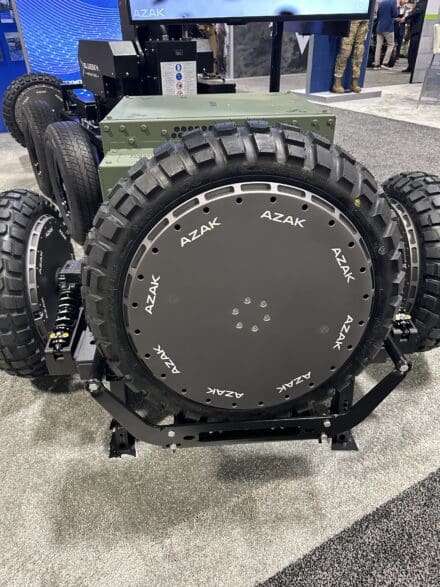GM Defense, a subsidiary of General Motors (GM), unveiled its new “Next Gen” tactical vehicle prototype at this week’s AUSA 2024, the annual meeting and exposition of the Association of the U.S. Army.
Based on the Chevrolet Silverado 2500HD ZR2 truck, the rugged and durable Next Gen combines GM’s 2.8L Duramax® turbo-diesel engine with a 12-module battery pack, in addition to drive motors for the front and rear axles that enable Silent Drive and Silent Watch, technologies that make the vehicles harder to detect.

Side view of GM Defense’s Next Gen tactical vehicle
The technologies enable stealthy ingress and egress through high threat zones, with onboard power to support high-energy-demand sensors, shooters, and Soldier kit. The vehicles offer active and passive safety features, including roll-over protection, anti-lock braking, electronic stability control, four- and five-point seat belt harnesses, and 360-degree camera capabilities.
“Our Next Gen vehicle is a game-changing mobility solution that delivers tactically significant capabilities by integrating GM’s proven commercial technologies,” said Steve duMont, president of GM Defense. “This rugged and highly capable diesel-powered vehicle offers tactical advantages, such as Silent Operations, exportable power, and increased range with extended mission duration. Our warfighters deserve the latest technology that industry can offer in order to gain and maintain competitive advantage over our adversaries. Our Next Gen mobility solution can be customized and fielded now.”
Next Gen offers the following tactical advantages:
• Silent Drive and Silent Watch, enabling low acoustic and thermal signatures;
• Exportable power capable of charging mission systems;
• Tactically significant range with extended mission duration;
• Designed to be autonomy-ready with manned and unmanned options; and
• Add-on armor capable.
In addition, Next Gen provides sustainment benefits, including:
• Fuel demand reduction;
• The ability to use existing JP8 fuel infrastructure;
• Lower maintenance requirements from reduced parts and subsystems in the overall propulsion system; and
• Reduced logistics tail for fuel, batteries, and vehicle parts.
“Next Gen’s ‘wow’ factor is right behind the wheel,” said John ‘JD’ Johnson, vice president of GM Defense’s Government Solutions and Strategy Division. “Customers need to drive this highly capable vehicle to see, feel, and hear the benefits. Next Gen fundamentally changes the discussion around modern mobility through the tactical benefits delivered by its propulsion system, including its ability to address the power gap in the formation. This highly capable tactical vehicle leverages billions of dollars of investments GM has made in R&D and innovation to enhance warfighter capability. We encourage customers to test drive it so that we can get these capabilities fielded immediately.”
Next Gen is offered in two-, four-, and six-seat configurations. The vehicle will be optimized to support multi-mission capabilities, including command and control, launched effects, network extension, counter unmanned aerial systems anti-armor, casualty evacuation, and other critical missions.























































































































